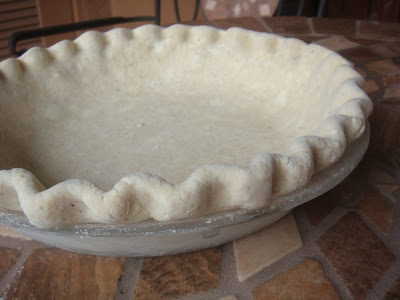
Now, I’ve made countless pie doughs both savory and sweet, but none have turned out as satisfyingly perfect as this one. Everything came together so quickly and effortlessly.

Making pie dough from scratch can be quite an ordeal, even for a seasoned baker. Many things play a factor in the end result, ingredients, temperatures, liquids…
I don’t use any super fancy or expensive ingredients in my pie doughs but, I do use fresh flour, unsalted butter and bottled water (we have big jugs of spring water at home).
As with all my pie dough, I started off with very cold ingredients (this is key); and I also took the extra step of chilling some of my equipment (the food processor bowl and blade). Proper chill time is crucial when making pie dough, cold ingredients = tender, flakey pie crust. I won’t go into the science, but trust me on this one.

The amount of moisture, which affects the texture, is also important. Dry dough doesn’t come together and soggy dough doesn’t roll out. The best way to know how much water to use, is to learn how to make dough by hand first, then by the cutting-it-in method and lastly the food processor. When you make dough with your hands or more correctly your fingers, you get to feel the different stages of the dough. When you cut the fat into the flour with knives or pastry cutter, you get a cramped wrist, but also another idea of what the texture of the fat and flour should be (before adding the water). Anyway, once you’ve gained that insight, I highly recommend using a food processor to make quick work of the whole process. But until you know what to look for when you’re using a processor, it can be difficult.

Moving on
When it came to rolling out my pie dough, I used a silplat mat dusted with flour (this was the first time I tried it this way and it worked superbly). No sticking or mess whatsoever. I’ve tried rolling the dough straight from the processor between two sheets of plastic wrap, chilling the dough in a disk first then rolling it out on a floured surface, and pressing the dough into a pie plate by hand (which I don’t recommend).

With the silplat, I rolled a perfect circle and the dough didn’t stick to the surface once. And when I laid the glorious dough round into the chilled pie plate, it hung over the edges evenly by 1-inch. Since I was able to quickly roll out the dough and have it fit nicely, I went ahead and folded under the overhang and then created a nice fluted edge.
I know I’m obsessed (hence the blog) but I was so happy with my pepper speckled crust, that I had a proud smile on my face as I lovingly slid it into the freezer. I know I’m a total nerd, oh well.
So here are the recipes I use to make all my crusts, both savory and sweet.
Basic Buttery Pie Dough
1 ½ cups flour
½ tsp salt *
1 stick (8 T) unsalted butter, chilled
5ish tablespoons ice water (yes I wrote 5ish)
First combine the flour and salt in a small bowl and give it a quick stir with a fork. Pop this into the freezer to chill. Next, cut the butter into 1-inch cubes and chill. Get your ice water ready. Once all the ingredients are well chilled, dump the flour mixture into a food processor and add the cold butter pieces. Process, in quick pulses, until the butter pieces are pea size (about 7 times). Pour in 3 tablespoons of ice water and process 4 times. Pour in 2 more tablespoons of water and process until mixture just start to form tiny crumbly balls (don’t let it form one big ball) and when pinched with your fingers, it sticks together.
Dump crumbly mixture onto a sheet of plastic, form into a disk, cover and let rest for 30 minutes in the refrigerator.
When ready to use. Roll out the dough into an even circle, roughly 1 inch bigger than the top of the pie plate. Ease the dough round into the plate (no stretching). Trim overhang so it’s even all the way around and fold edges under to create a smooth surface. You can form whatever decorative edge you want now.
*For a savory pie dough, you can use ¼ tsp of pepper in addition to the salt, like I do when I make my quiche.
*For a sweet version, do ½ tsp salt and 1 tablespoons of sugar.

Flakey Buttery Pie Dough
1 ½ cups flour
½ tsp salt
¼ cup unsalted butter, chilled
¼ cup butter shortening, chilled*
5ish tablespoons ice water
Same method as above, except add the shortening to the flour and pulse 3 times then add the butter and pulse until fat is pea size. Then continue with the water and pulsing.
*For a more flakey crust, use shortening. And to get a better butter flavor, use Butter-Flavored Crisco instead of plain.
*The sweet and savory version measurements still apply.
Have I lost anyone :)
Photos coming soon!


3 comments:
Thank you for the pie crust recipes. It's nice to have something tried and true in my recipe folder. I will need to buy a silplat though.
Summer - you lost me on about the fourth paragraph. I'll say it again - Butter and Cream!!!!!
Yes, Butter and Cream!
How fun to have a quaint little family bakery.
I can picture the morning sun shining through the windows and yummy pastries being set out into the display cases as the scent of freshly brewed coffee fills the air...awww...mmmmm...Butter and Cream.
Mom- let me know what you think of the crust if you use one of the recipes.
Thank you two for being the only readers of this blog :)
Post a Comment